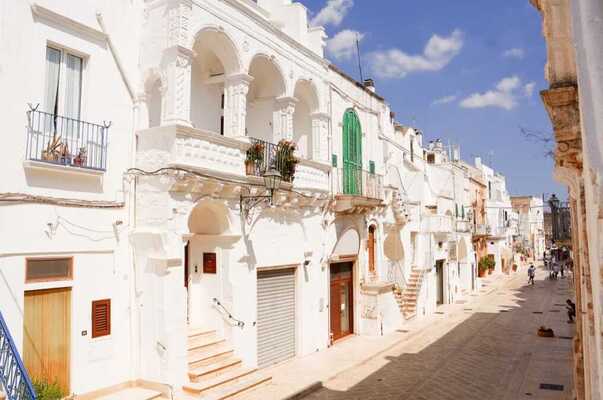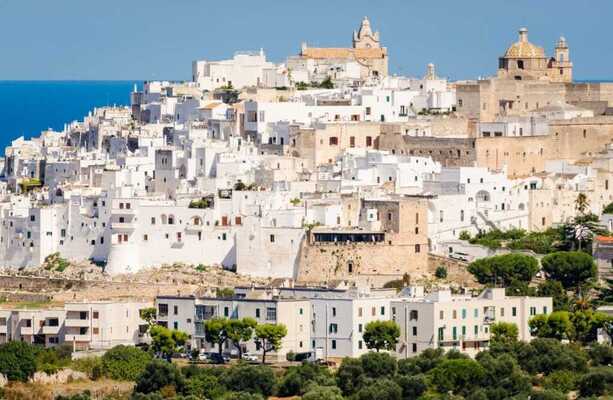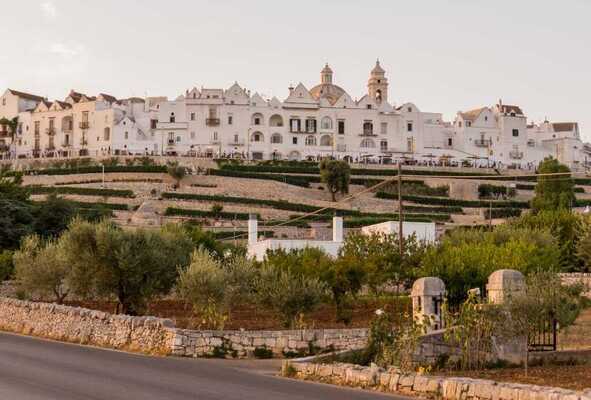Itria Valley
It extends to the center of Puglia between the provinces of Bari, Brindisi and Taranto, coinciding in the southern part with the Murge plateau. We are talking about the famous Itria Valley, also called “Trulli Valley” due to the presence of these typical cone-shaped buildings.
In this large and flat karst basin, in which the trulli, the verdant countryside, carefully cultivated with vineyards, vegetable gardens, fruit trees, the dry stone walls, the tiny country lanes contribute to the definition of a pleasant and fascinating landscape picture.
The climate is characterized by harsh winters and hot, long but often windy summers, with interesting temperature variations.

Itria Valley among vineyards and olive groves
The Itria Valley welcomes visitors with a large expanse of vines and olive groves. Viticulture tends to be based on white grapes, with the famous wines of Locorotondo DOC and Martina Franca DOC; the main variants are Verdeca and Bianco d’Alessano.
In Lower Murgia, however, we return to the classic Apulian vocation for reds with the Primitivo grape, the cornerstone of the Gioia del Colle DOP.
Surrounded by rows of dry stone walls, from the milky white lime of the unmistakable trulli stand out extensive countryside of olive groves that produce delicious extra virgin olive oil.

Unmissable stops in the Itria Valley
- In the heart of the Itria Valley, an obligatory stop is Alberobello, a UNESCO world heritage site since 1996 with its fascinating trulli which, in a fairy-tale setting, hosts the Living Nativity scene in December and the Living Passion during the Easter period.
- Not least are Cisternino with its countryside dotted with these trullo-shaped buildings, together with nearby Locorotondo; a beautiful village called this way precisely because of the characteristic round shape of the town.
- Not far away, in the municipality of Castellana Grotte you can visit the famous Castellana Caves. The Grave, the first and largest cave of the underground system naturally connected to the outside; and the last and most beautiful cave, the White Cave, defined as the brightest in the world.
- A few kilometers from the province of Bari, we find Martina Franca (TA), the most populated municipality in the Itria Valley. Known for its baroque architecture and music festival held in summer.
- The only city in the valley with an outlet to the sea is the beautiful Ostuni: the so-called “White City”, due to its historic centre, once painted completely with white lime.
- Towards the province of Brindisi, in the Fasano plain, full of farms, resorts and ancient homes, lies the forest of the same name within which the Zoo Safari is located, a park that is home to over 40 species of animals in the wild.
- Very close is the Archaeological Park of Egnazia which is located a few kilometers from the sea. The rooms of the museum preserve over 30 centuries of history dating back to the Bronze Age, passing through the Roman era up to the late ancient period.

Typical products and tourist routes
Currently the Itria Valley is one of the areas with the greatest tourist attendance; rich in numerous historic centres, as are numerous farms (masserie) that offer walks, workshops and tastings.
Being one of the most evocative places in the Apulian territory, it also offers characteristic dishes such as gnummareddi, lamb or veal meat rolls; the lampascioni omelette, a type of wild onion; the orecchiette with turnip greens and the delicious capocollo of Martina Franca, pork loin.
The territory of the valley is dotted with wooded areas and lesser-known views but which represent a cross-section that distinguishes the murge of the trulli.
In fact, there are several itineraries that can be followed for trekking or mountain biking enthusiasts, which include the districts of the municipalities of the Itria Valley.
Among the most interesting itineraries are those along the Apulian Aqueduct canal in the various practicable sections or along the Pirro Canal, offering unforgettable scenery.

Cisternino
Cisternino, one of the most beautiful villages in the Itria Valley where history, popular traditions and good food blend together with a family welcome.

Ostuni: the “white city”
Picturesque and renowned tourist destination, it boasts a medieval village with winding streets and whitewashed houses. Divided between the old city known as the "land" and the more recent "marina" one, it offers evocative views of stairways, alleys and small squares overlooked by shops, small shops and typical restaurants.

Locorotondo – among the most beautiful village in Puglia
Locorotondo, a small Apulian village where you can get lost in the alleys of the historic center admiring the characteristic houses with sloping roofs and centuries-old churches.
